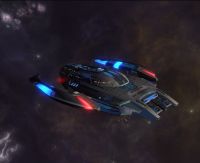Aquarius Class Light Escort
Technically classified as a light escort due to its armaments, the Aquarius-class starship is a small, versatile vessel initially designed to support the Odyssey-class explorer as a first-of-her-kind embarked vessel. Since the first two were built in the mid-2380s, the class’s usage has expanded beyond just supporting the Odyssey-class, with units of this class serving as patrol cutters and starbase support ships, and in other light-duty assignments throughout the Federation.
Class History
The Aquarius class was designed along with the Odyssey-class explorer, a feature that was added to the design following the successful introduction of the Prometheus class in the late 2370s. Initially, it was envisioned as a much more significant component of the Odyssey, but this was deemed unfeasible. Instead, a design based on the Defiant and Diligent-classes was produced which would answer some of the Odyssey’s weaknesses that resulted from her large size: the Aquarius would both be able to provide combat support against small, fast targets, but also to land on planetary bodies when a runabout or shuttle wasn’t enough for a particular mission.
While integrated support craft such as captain’s yachts, aeroshuttles, and waveriders were not a new idea in Starfleet, this would be the first time that an entire starship would be carried aboard another. The Aquarius was launched at the same time as the Odyssey, and her trials were uneventful. For several years, the only two members of this class produced were assigned to the Odyssey and Verity, which were launched significantly earlier than planned to participate in the Romulan Evacuation.
With the other Odysseys several years away, Starfleet decided to continue producing Aquarius-class ships to serve different purposes, as they had carved out a niche for themselves that was distinct from other small starships: they were far less maintenance-intensive than the Defiant and crew-intensive than the Diligent or Nova. This made them suitable for the sorts of minor missions that had long been carried out by the ancient Oberth-class starships still in service like courier runs, search and rescue, and specimen collection, which would be wasteful for a more capable ship to perform but too complex for a runabout to do. As such, units of this class began to be built and assigned to starbases as support ships.
By the early 2390s, the class has been given a generous production run and is becoming increasingly common in Starfleet service in lightly populated and low-threat areas.
Shipboard Life
While some Aquarius-class starships, especially those not assigned directly to a starbase or Odyssey-class explorer, have a permanent crew, their crews are much more likely to be drawn from their home command based on the particular mission profile. For instance, a science officer might be selected to command one during a survey mission, while the mothership’s first or second officer usually takes command during combat missions. During typical situations, while docked with an Odyssey, a skeleton crew remains aboard to allow for quick deployment, with a designated commanding officer for each shift.
Given the very temporary nature of assignments to this ship, crew members tend to identify more as being a part of their home command than the Aquarius, though as crew members cycle through assignments on the support ship, some will inevitably develop an attachment to the romance of serving on a scrappy little vessel. While crew members aboard the Aquarius might never interact while among the large crew of a starbase or Odyssey-class ship, the much smaller environment of the Aquarius lends itself to either making new friendships or letting minor annoyances foment rivalries.
These rotating crew assignments help offset the fact that the Aquarius-class has even more spartan accommodations than the Defiant-class, as it’s meant to be an even lower endurance platform. While there are four single-occupancy cabins (usually for the captain, first officer, engineering officer, and medical officer), other officers are in cramped double-berth cabins, and enlisted personnel share one four-person cabin and four bunk rooms with ten to twelve bunks each. The standard crew complement is 40, but the ship can operate for limited periods with just a bridge crew, or with hot-bunking can accommodate up to 72 in terms of life support and escape pod capacity.
The only dedicated recreational space is the mess hall. Each cabin and bunk room have a table and chairs and a replicator, but the crew tends to congregate together for meals, cards, drinks, and games. When not full of cargo and equipment, the cargo hold and shuttle bay can be secondary recreational spaces, especially for athletic activities.
The Aquarius class has an oversized sickbay for its size, with four standard biobeds and a combination exam-surgical bed. This increases the ship’s utility for search-and-rescue operations, which are common assignments for vessels of this class assigned as patrol cutters. It also obviates the need to return to the home command for minor to moderate medical problems. The ship is equipped with an EMH and typically embarks a medical officer and an enlisted medic. The transporter room aboard the Aquarius class is similar in design to those found aboard the Nova-class, with a standard seven-place platform.
